Pablo Picasso Original Hand Signed Vintage Painting Bullfighters Modern Art Rare
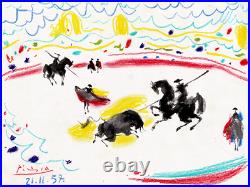
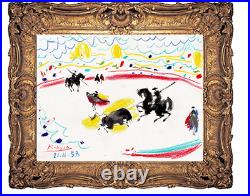
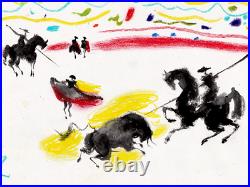
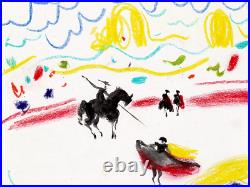
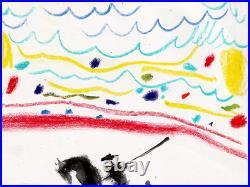
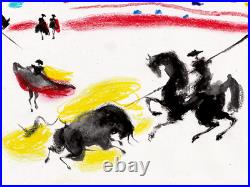

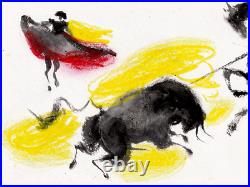
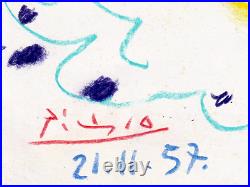

PABLO PICASSO A 1957 ORIGINAL VINTAGE PAINTING PICADOR AND BULL NO PRINT RARE. Picador and Bull - 1957.
Original ink and crayon painting on paper 26 x 34 cm. Original painting drawing signed Picasso abstract nude figures modernism modern art. In this beautiful composition, a bullfight scene. Signed Picasso, lower left margin. Also dated 21.11.57. The artwork was executed in black and crayon. It measures 26 x 34. Minor yellowing visible on the paper, which is normal for a work of art this age, otherwise in excellent condition. This captivating work of art by master artist Pablo Picasso is a must have to any art collection. Please note the frame is not included in the sale. Signed Picasso lower left Corner. Medium ink and crayon on paper. Please note the frame on the listing is for illustration purposes only. Picasso was a Spaniard by birth. Hailing from the town of Málaga in Andalusia, Spain, he was the first-born of Don José Ruiz y Blasco and María Picasso y López.He was raised as a Catholic. Pablo Picasso's father was an artist in his own right, earning a living painting birds and other game animals.
He also taught art classes and curated the local museum. Don José Ruiz y Blasco began schooling his son in drawing and oil painting when the boy was seven, and he found the young Pablo to be an apt pupil. Picasso attended the school of Fine Arts in Barcelona, where his father taught, at 13 years old.
In 1897, Picasso began his studies at Madrid's Real Academia de Bellas Artes de San Fernando, which was Spain's top art academy at the time. Picasso attended only briefly, preferring to roam the art exhibits at the Prado, studying works by El Greco , Goya , Diego Veláquez and Zurbáran.
During this nascent period of Picasso's life, he painted portraits, like his sister Lola's First Communion. Because the 19th century drew to an in depth , elements of Symbolism and his own interpretation of Modernism began to be apparent in his stylized landscapes.
In 1900, Picasso first visited Paris, the middle of the European art scene. He shared lodgings with Max Jacob, a poet and journalist who took the artist under his wing. The 2 lived in abject poverty, sometimes reduced to burning the artist's paintings to remain warm. Before long, Picasso relocated to Madrid and lived there for the primary a part of 1901. He partnered together with his friend Francisco Asis Soler on a literary magazine called "Young Art, " illustrating articles and creating cartoons sympathetic to the poor.
By the time the primary issue came out, the developing artist had begun to sign his artworks "Picasso, " instead of his customary Pablo Ruiz y Picasso. The Picasso art period referred to as the Blue Period extended from 1901 to 1904.
During this point , the artist painted primarily in shades of blue, with occasional touches of accent color. For instance , the famous 1903 artwork, The Old Guitarist, features a guitar in warmer brown tones amid the blue hues. Picasso's Blue Period works are often perceived as somber because of their subdued tones. Historians attribute Picasso's Blue Period largely to the artist's apparent depression following a friend's demise.
A number of the recurring subjects within the Blue Period are blindness, poverty and also the female nude. The Rose Period lasted from 1904 through 1906. Shades of pink and rose imbued Picasso's art with a warmer, less melancholy air than his Blue Period paintings.
Harlequins, clowns and circus folk are among the recurring subjects in these artworks. Elements of primitivism within the Rose Period paintings reflect experimentation with the Picasso art style. During his African art and Primitivism period from 1907 to 1909, Picasso created one among his best-known and most controversial artworks, Les Damoiselles d'Avignon. Inspired by the angular African art he viewed in an exhibit at the Palais de Trocadero and by an African mask owned by Matisse , Picasso's art reflected these influences during this era. Ironically, Matisse was among the foremost vocal denouncers of "Les Demoiselles d'Avignon" when Picasso first showed it to his clique.
From 1907 to 1912, the artist worked with fellow painter Braque in creating the beginnings of the Cubist movement in art. Their paintings utilize a palette of earth tones. The works depict deconstructed objects with complex geometric forms. His romantic partner of seven years, Fernande Olivier, figured in many of the artist's Cubist works, including Head of a woman, Fernande (1909). Historians believe she also appeared in Les Demoiselles d'Avignon.
Their relationship was tempestuous, and that they separated permanently in 1912. This era of Picasso's life extended from 1912 to 1919. Picasso's works continued within the Cubist vein, but the artist introduced a replacement art form, collage, into a number of his creations. He also incorporated the human form into many Cubist paintings, like Girl with a Mandolin (1910) and Ma Jolie (1911-12). Although variety of artists he knew left Paris to fight in war I, Picasso spent the war years in his studio.
He had already fallen enamored with another woman by the time his relationship with Fernande Olivier ended. He and Eva Gouel, the topic of his 1911 painting, "Woman with a Guitar, " were together until her untimely death from tuberculosis in 1915.
Picasso then moved into a quick relationship with Gaby Depeyre Lespinesse that lasted only a year. In 1916-17, he briefly dated a 20-year-old actress, Paquerette, and Irene Lagut. Soon thereafter, he met his first wife, Olga Khoklova, a dancer from Russia, whom he married in 1918. That they had a son together three years later. Although the artist and therefore the ballerina became estranged soon thereafter, Picasso refused to grant Khoklova a divorce, since that meant he would need to give her half his wealth. They remained married in name only until she died in 1955. The Picasso art period extending from 1919 to 1929 featured a big shift a la mode. Within the wake of his first visit to Italy and therefore the conclusion of war I, the artist's paintings, such as the watercolor Peasants Sleeping (1919) reflected a restoration of order in art, and his neoclassical artworks offer a stark contrast to his Cubist paintings. However, because the French Surrealist Movement gained traction within the mid-1920s, Picasso began to reprise his penchant for Primitivism in such Surrealist-influenced paintings as Three Dancers (1925). In 1927, the 46-year-old artist met Marie-Therese Walter, a 17-year-old girl from Spain. The 2 formed a relationship and Marie-Therese gave birth to Picasso's daughter Maya.They remained a couple until 1936, and she or he inspired the artist's "Vollard Suite, " which consists of 100 neoclassical etchings completed in 1937. Picasso took up with artist and photographer Dora Maar within the late'30s. During the 1930s, Picasso's works such as his well-known Guernica, a singular depiction of the Spanish war , reflected the violence of war time.
The menacing minotaur became a central symbol of his art, replacing the harlequin of his earlier years. During world war II, Picasso remained in Paris under German occupation, enduring Gestapo harassment while he continued to make art. Some of the time, he wrote poetry, completing more than 300 works between 1939 and 1959. He also completed two plays, "Desire Caught by the Tail, " and The Four Little Girls. After Paris was liberated in 1944, Picasso began a brand new relationship with the much younger student Francoise Gilot.Together, they produced a son, Claude, in 1947, and a daughter, Paloma, in 1949. Their relationship was doomed like numerous of Picasso's previous ones, however, thanks to his continual infidelities and abuse.
He focused on sculpture during this era, participating in an international exhibition at the Philadelphia Museum of Art in 1949. He subsequently created a commissioned sculpture referred to as the Chicago Picasso, which he donated to the U. In 1961, at the age of 79, the artist married his second and last wife, 27-year-old Jacqueline Roque. She proved to be one among his career's greatest inspirations.Picasso produced more than 70 portraits of her during the final 17 years he was alive. As his life neared its end, the artist experienced a flurry of creativity. The resulting artworks were a mix of his previous styles and included colorful paintings and copper etchings. Art experts later recognized the beginnings of Neo-Expressionism in Picasso's final works.
Picasso's Influence on Art. As one of the best influences on the course of 20th-century art, Picasso often mixed various styles to make wholly new interpretations of what he saw. He was a driving force within the development of Cubism, and he elevated collage to the level of art. With the courage and self-confidence unhindered by convention or fear of ostracism, Picasso followed his vision because it led him to fresh innovations in his craft. Similarly, his continual quest for passion in his many romantic liaisons throughout his life inspired him to make innumerable paintings, sculptures and etchings.
Picasso isn't just a person and his work. Picasso is always a legend, indeed almost a myth.
Within the public view he has long ago been the personification of genius in modern art. Picasso is an idol, one among those rare creatures who act as crucibles in which the diverse and sometimes chaotic phenomena of culture are focused, who seem to incarnate the artistic lifetime of their age in one individual. The item "PABLO PICASSO ORIGINAL HAND SIGNED VINTAGE PAINTING BULLFIGHTERS MODERN ART RARE" is in sale since Thursday, May 14, 2020. This item is in the category "Art\Paintings".
The seller is "sco-jone" and is located in Omaha, Nebraska. This item can be shipped worldwide.
- Size: Medium (up to 36in.)
- Region of Origin: Europe
- Artist: Pablo Picasso
- Style: Modern
- Listed By: Dealer or Reseller
- Quantity Type: Single-Piece Work
- Painting Surface: Paper
- Medium: Gouache
- Date of Creation: 1950-1969
- Original/Reproduction: Original
- Year: 1957
- Features: Unframed, Signed
- Color: Multi-Color
- Subject: Horses
- Originality: Original
